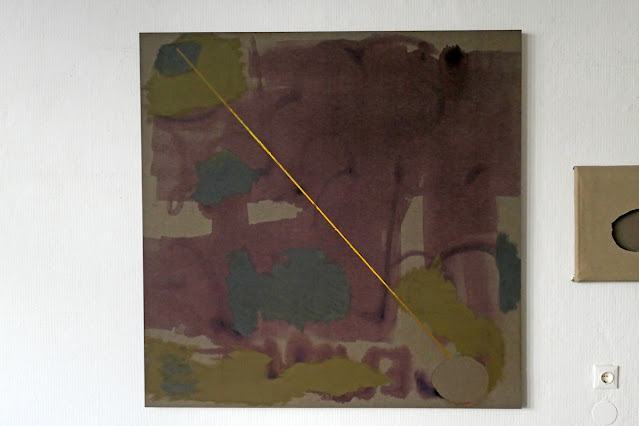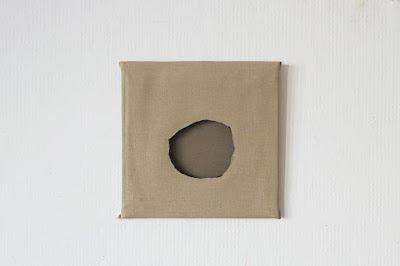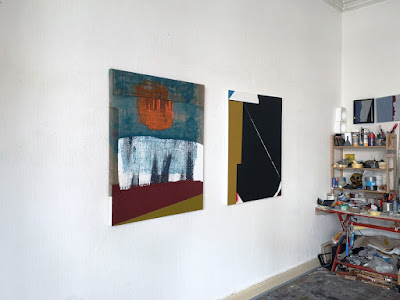---
 |
OLD MASTERS. With the aim of brightening with a shy smile (in order to have a blast, let's say) this typical February Sunday afternoon in Berlin (greyish, snowy, windy, icy, faded), here is a small selection among the fifty photos of a series made around 2013, using a woman's bonnet in smooth dark green wool. But let's not get caught in the trap of this few bursts of laughter with which I am able here and there to sprinkle the dull stream of life: day by day I'm afraid to be a rather boring fellow, man of few words, above all interested in painting and particularly in its dialectical, critical, aesthetic-political dimension and significance. (As Pierre Bourdieu probably said, well understood eclecticism drives the painter to always do the same thing, but on various terrains and in distinct fields.) |
---
 |
CHRISTMASTIME 2020. |
---
 |
| CROSSING OUT (or the painting is an illegible tongue), 130x130cm (51x51"), acrylic paint and oil on canvas, 2021. |
---
 |
THE MUSEUM ATTENDANT TOLD ME NOT TO TOUCH THE PAINTING, 160x150cm (63x59"), oil stick, linen on canvas, cut, acrylic paint, 2021-2013.
. In 2013, parallel to my "abstract" production and perhaps to shed light on it by digging into the complex relationship between image and language, the underlying narration and the inscription of a form on the canvas, a form accompanying or resisting the narration, but always, in one way or another, linked to the words allowing to describe it, therefore to define it, I got it into my head to make a small group of figurative paintings, "portraits" of writers who matter to me. This is how I started to paint Samuel Beckett, Marlen Haushofer, Robert Pinget, Gertrude Stein and Franz Kafka, among others. Finally, this series was aborted and the canvases remained in a corner. But they were reused by me or by other artists later. This painting went through three successive stages: the Beckett stage, the museum watcher phase and the current situation. I leave the following photos to testify of this process, chronologically, from 2021 to 2013. . Some notes about process and method. The part on the right, which extends to the yellow stripe, belongs to the painting which now lies under the linen, on the left. The linen was gently stretched over the entire surface, so i couldn't see the first painting anymore. The linen was painted vertically on a wet surface, using a color relatively close to that of this underside, as far i was able to recall, doing it. Then the linen was cut from top to bottom to release the right underside, which became visible again. Some tape was laid along the physical cut, to the right of it and i painted the stripe yellow which, when i removed the tape, was in turn cut along its entire length. I then materialized the verticality of the left part using a blue oil stick. Finally I painted the "gray" part on the left, and the linen stretched out enough to draw the curves you can see now. Hoping it's understandable... |


---
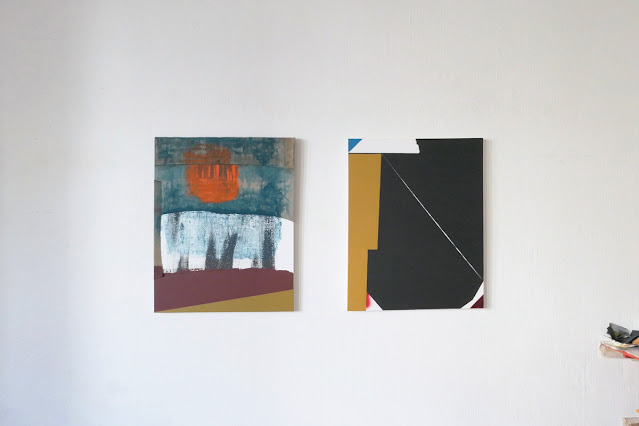 |
| UPDATED MUSKETEERS 2021, part 1/2. Fourth version of my three musketeers 2019 (one of these is still on the feed), 100x80x4cm (39.4x31.5x1.6") each. Cut-out, collage, gesso, acrylic, spray, Bic, enamel and oil on canvas. |
---
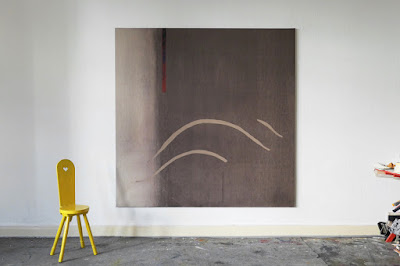 |
THE WAVES, 185x185cm (72.8x72.8"), acrylic paint, lacquer paint and oil on linen, 2020, in memory of the eponymous novel by Virginia Woolf, published 1925. In this case the canvas was stapled to the frame but wasn't stretched. The linen, in contact with the humidity of the first layer of diluted acrylic paint, shrank a lot, but retained some surface ripples which i subsequently used as pictorial patterns, but shifted, elsewhere and contradicting their naturalness. And since i know that the scale of large paintings disappears on the ridiculous screen of a telephone, and moreover that THE WAVES is not particularly pleasant, i added the small yellow stool with its empty heart. In addition maybe to be noted that during all the work, like "a fin in a waste of waters", another reference was present, insistent: the Senza titolo (Notte), by Jannis Koulellis, 1965. In short: painting and language, how does this work, memory, remembrance, recollection and painting, how does this work, this kind of stuff, u no. There are people who, when they get up have only one hurry, and that is to speak in order maybe to distract themselves from the death of the night and from the night of death, while others do not aspire than to stay silent in the early morning. For my part it is in silence that i can collect the fruits of the night, impressions, fragments, vertigos, gleams, colors and gradients, shapes, affects, sparks, ellipses, rebuses, words, dreams and reflections that will nourish the furnace of the work in progress or to come. Certain paintings having macerated more deeply than others in this nocturnal potion, therefore risk appearing as bathed in moonlight at the end. It is not wrong from my point of view to say that painting is a "cosa mentale", even if the meaning of these words must have changed a little since. |

---
 |
Harry Member (about sculpture). Painted cardboard (two parts), 200x110x90cm (79x36x43"), late 2020. . A sculpture is an object, an autonomous volume exclusive of all other objects not considered as sculptures. An object endowed with certain qualifications which, in a given context, will be considered as a sculpture, insofar as the subject, the person who will have designed and built it, or had it built, will have known how to inscribe it (impose it) in the traditional field of all existing and future sculptures (memory and projection). This is either by putting it in relation with this field, or by rupture (which is a stressed form of this connection). Each sculpture therefore contains a mirror, a tautology, a blinding and deliberate reference aimed at ensuring that it is henceforth understood as art and not as an unidentified no flying object. As such, 90% of a sculpture is not made of stone, metal, wood, cement or cardboard, but of signifier, that is to say of language, of belief. . How to make coincide? For example, how do you make the open and the closed, the top and the bottom, the pinkish and the beige coincide? How to put them in contact? By what attraction, which will not suffocate any part by making it a base, a support, prop, holder, plinth? Isn't a plinth also an atrophied, stillborn sculpture, a corpse on whose torso stands up its murderous and triumphant brother (or sister)? We do not care about the dead who precede us, not having known them during their lifetime, and yet there are many, it is an expanding mass. In art there are also many corpses that we do not want to see. But maybe i just replaced the cold, technical and restrained "pompousness" of a kind of puritanical minimalism with a pathetic (another side of the "pompousness") linked to the constitutive weakness of a transitory material. |



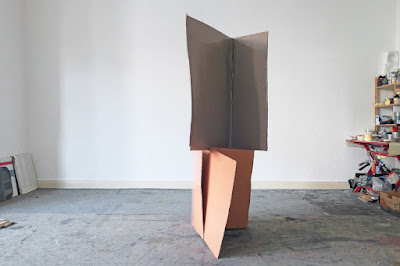

---
 |
STAR'S CASE, 185x185cm (72.8x72.8"), gesso, pigments and acrylic paint on canvas, 2021.
. I believe that my interest in painting stems from striking juvenile perceptual experiences, relating to surface, volume,
transparency and, or, opacity. At least, if it does not come from that, but
from elsewhere, it is in this sort of experience that my interest in painting crystallized,
or can be formulated, since this is how i speak of it.
One example?
My grandmother's pool. (We were used to call it: "le bassin", and here i must not forget
that "bassin" means also pelvis.) On the terrain at the top of my grandmother's
property, my grandfather (whom i didn't meet because he died more than twenty years before i was born) had a pool built for the irrigation of the garden and the vegetable
garden in case of drought, the municipal water distribution in summer, in
Aix-en-Provence and at that time, being severely rationed. Seeing it, you could
just as easily have said a water tank than a pool, insofar as it was not
embedded in the ground, but that it rose above it, like a large block of cement
about five feet high, thirteen wide and thirty long, filled with water
to the brim, the surface of which was reflecting a cherry tree while in its
depths glided goldfish. It was both utilitarian and beautiful, but the
actual unsettling experience was, leaning with your whole body against that
wall, to know that water was piling up behind it, vertically. A parallelepipedic big mass of water, so to speak, and a volume of transparency. |




---
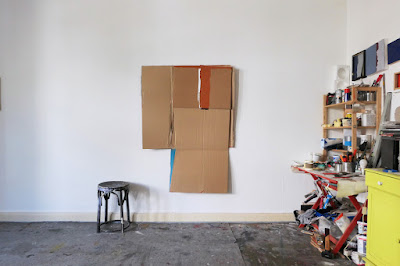 |
UNDERCLOTHES. Enamel and oil on folded cardboard, 2020. The good thing about cardboard lies in its unlimited ability for transformation, due to its lightness and lightweight, and to its versatile rigidity (which allows it to adapt to all desires while maintaining a relative planarity and flatness of the surfaces); but perhaps above all due to its indifference (in front or behind, it's the same). In short, cardboard is a first-class polymorphic pervert, it is the childhood of art. From painting to sculpture and back in the blink of an eye, it is far from the hysterical character of the free canvas, from the paranoid and psychorigid personality of wood, stone or metal. So, from this point of view, when a painter works on a canvas stretched on a frame, he or she is dealing with a neurotic background.
. Current fate of this cardboard: one part must currently decay in the Aspen (Colorado) waste management center, as it was used to pack an artwork by Laurence Grave, which was shipped to a collector there. The other part has become a sculpture of which i will post the pics one of these days. In the future, it can be expected that this first part will be transformed into packaging for eggs, or moving boxes, which will perhaps make it travel even further and, who knows, even to China, when the GoGo Company will take care of the stuff of John Smith, undercover intelligence officer who will have been assigned to Beijing as part of his employment with Madira, an international firm specializing in the export of fine wines and expensive spirits. And so on... |

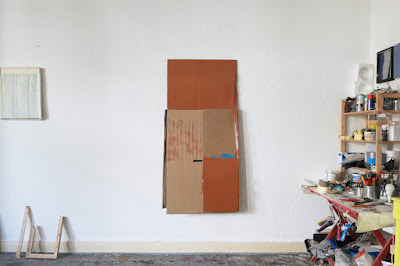



---
 |
| IS MARY's PLAIT FLAT ENOUGH? 185x185cm (72.8x72.8"), enamel and diluted lacquer paint on canvas, 2020. |
---
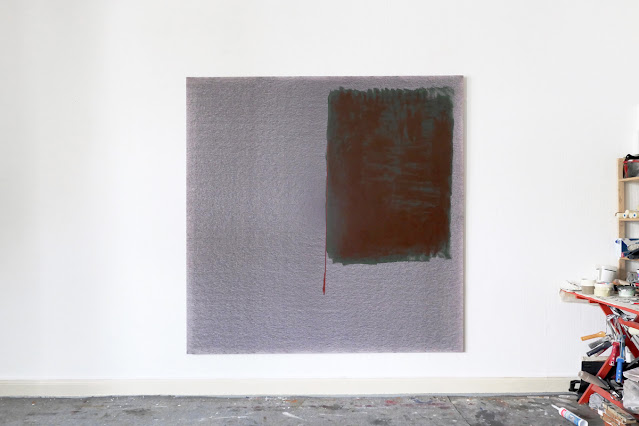 |
| PARTITION, 185x185cm (72.8x72.8"), oil on diluted lacquer paint on canvas, 2020. |
---
 |
| DELAYED IMPLOSION, 185x185cm (72.8x72.8"), enamel and diluted lacquer paint on canvas, 2020. Related dialectically to the previous painting, and to all the others, with an acrobat by Picasso as reference to flatness, which drives to Cézanne, which drives to Renaissance, which drives to ... |
---
 |
PUSHPIN AND THE BALL, 185x185cm (72.8x72.8"), diluted lacquer pain, enamel and oil on canvas, 2020. . It's the end of summer, sun is shining on a radiant countryside, dropping its gentle heat on your soothed face, you take your bike for a ride away from the dwellings, hopping on a mossy path, miles pass, rabbits frolic in the thick grass, birds chirp over the moist earth, in a verdant greenery, prolific and serene, God! it's a royal peace, and then your tire bursts (on a rusty short nail left there by a hoof one hundred and fifty-seven years ago).
|
---
 |
FOCUSED APPROACH, 185x185cm (72.8x72.8"), diluted lacquer paint and oil on canvas, 2020. . Like Alice nibbling a piece of mushroom suddenly changes scale, withdrawing one word from the comment of my previous post by putting for a short moment a magnifier over it: ethical, before returning to more specifically pictorial considerations, one might think. Relatively to my perfectly questionable point of view, insofar as i'm somewhat opposed here to common conceptions, it seems to me that if moral and morality are a common ideological form, which implicitly or explicitly aims to have as many people as possible adopt the same attitude and the same behavior (through a grid of references and values ((religious, political, cultural)) shared either by adherence, or by fear, or in a hypocritical and self-interested way), ethics concerns one and only one individual and therefore cannot be taught or shared. Thus Kantian thought degrades and becomes vulgar as soon as it is adopted by someone other than Kant himself, and that in the best of cases, because in the worst it will take you directly to the concentration camp. Never embody the concepts. But anyhow this is only a very rough sketch that one should have the ability to develop ... Jackson Pollock and Simon Hantaï as ethical painters; shorting or shortcut? |




---
 |
| SUMMER HOMEWORK 2020 part 2. Second grouping of gouaches on Canson 32x24cm (12.6x9.4"). Sharper than the last one: a graphic representation of an object in space. Always fun to see how much work the simplest things need. |
 |
| SUMMER HOMEWORK 2020 part 1. Gouache on Canson, 32x24cm (12.6x9.4"). |
---
 |
| WATERSHED, or : La ligne de partage des eaux, 185x185cm (72.8x72.8"), diluted enamel and glossy lacquer paint on canvas, 2020. The topic of limits concerns some artists more than others. In painting, the limit is sometimes related to the marking of a separation (bound, edge, threshold, cap, border, delimitation, frontier, extent) which can be physically materialized and or visually designated by a line, a transition, a specific 'surface treatment', a juxtaposition or a partial superposition, a different appearance between two zones of the same color, a cut, a degradation, a vibration of the hue ... and so on; can be also through the inscription of a pictorial motif, whether abstract or figurative, but undoubtedly and above all by a particular 'speed', which itself is not directly related to the options already mentioned. A special intensity that in fact greatly exceeds the means, maybe beyond the aesthetic. On this basis, one could say that these raised points and ways are only methods, tools that make it possible to draw the limit, to manage its representation, but not necessarily to achieve the boundary. (Example of limits' painter, only from my point of view: Paul Gauguin.) And as Webster says : A dividing ridge between drainage areas ; A region or area bounded peripherally by a divide and draining ultimately to a particular watercourse or body of water ; A crucial dividing point, line, or factor ; the time of day after which television programs not appropriate for children may be broadcast: the nine o'clock watershed ; An area of tissue that is located at the periphery of two separate arterial systems. |








 |
| HOMEWORK SUMMER 2020, flattening the starfish; 65x70cm (25.6x27.5"), cutout, montage, marker and oil on plastic board. Between line and surface, drawing and (with) painting, a reinterpretation of my aluminum STARFISH. |
---
 |
| THE EXHAUSTING PINEAPPLE HARVEST, 2020, 185x185cm (72.8x72.8"), acrylic and oil on canvas. In order to dig a little deeper into what was sketched out in the comment of my previous post, i would advance the hypothesis that this question of the limit can be more 'ethical' than aesthetic, the latter being then 'only' the metaphor of the first one, its material application and its sensitive effect. This implies that the methods are not radically decision-making (if they are only the handle of the hammer, the extension and the result of the use of the tool). So, if the partial impregnation of a free, blank canvas with a liquid tint differs from the strict drawing of a line painted in oil (using scotch tape on a prepared and immaculate linen canvas stretched on a hard edged wood frame) are two different approaches to each other, their results can be closely united, conceptually speaking, from the presuppositions that presided over the creation of two paintings apparently at the antipodes. From this point of view, it is possibly conceivable that there is in fact no substantive difference between these works, contrary to what one might believe at first sight. Lucubrations to be continued in the next episode, perhaps. |







---
 |
| THE POOL (or the lightness of references), 185x185cm (72.8x72.8"), acrylic and oil on canvas. / It is a few months ago already, by re-reading the superb pages that Jacques Lacan devoted to painting, that i scribbled this project on a post-it (last pic). Actually it is from the conjunction of the cover picture of his book, picturing The Ambassadors by hans Holbein, 1533, and my persistent memory of this great and large painting by Goya: La junta de Filipinas, around 1815, that i was lucky enough to see about thirty years ago at museum of Castres in France, that came to me the lasting desire to paint THE POOL. In the case of Holbein's painting, it was the background that fascinated me, in that of Goya, it was emptiness, void and political criticism. When we see it for real (the painting is much wider than that allowed by this screen), the characters are so lost, insignificant in this sinister space, that we wonder who had the intelligence and the courage to buy it from him. I have to add that Holbein's painting systematically refers me, who knows why, to the sculpture of Tony Smith, 'Die' (the first model, 1962, my fav), but for shape reasons, not thematic or existential grounds ... Or maybe exactly the opposite of what i have just written: for symbolic reasons. |









---
 |
| SLICES, 185x185cm (72.8x72.8"), lacquer paint and enamel on canvas. / Process, method, making, surface, planarity, perspective, expressivity, transparency, flatness and depth, color and light. |
---
 |
| POLYZWEI (framing the frame), two parts, 2020, 76x76x3cm (30x30x1.2") and 48x48x5cm (19x19x2"), cutout, collage, gesso, acrylic and enamel on canvas and wood. / Making two with one and one from two, so four. |
---
 |
| TRUTH OF FAKE, 170x170x4cm (67x67x1.6"), oil on canvas, 2020. It seems to me that whatever the heterogeneity of the stylistic elements that one brings into play in a painting, the result must achieve, in addition to keep visible that constructive implicit criticism, an overall coherence, in order to be 'understandable' too. |
---
 |
| L'ART DU COLLAGE (or the bonding of the art is the art of mounting), 2020, 184x184cm (72.5x72.5"), cutout, collage, lacquer paint and marker on canvas, and then my reworked CECI N'EST PAS UN MATISSE, 170x170x5cm (67x67x2"), cutout, linen, collage, charcoal, gesso and oil on canvas. / The appearance of L'ART is quite unpleasant. It is a relatively shiny surface due to the lacquer paint i used. It looks like, in fact, a kind of oilcloth stuffed with very colorful patterns. It is one thing to see a pic on Instagram, as big as a large postage stamp, another to face it physically in a room ... About CECI i did my best, but it is particularly difficult to photograph. The subtle differences between the three whites (gesso, Guardi primer and titanium white oil) disappear with the shooting. Pity. / Between the vulgarity of one and the nuances of the other, it is a bit like the encounter of opposites, connected by a method, an approach of the image. |
---
 |
| Reworked one, finished two, 2020. / Left: Untitled, 30x30x6cm (11.8x11.8x2.4"), oil on wood; middle: MAXI, 20x20x4cm (7.9x7.9x1.6"), acrylic, enamel and oil on canvas and wood; right: Untitled, 30x30x3cm (11.8x11.8x1.2"), oil on wood. / All about surface, perspective and depth. Not death, depth! |
---
 |
| DUCKY DUCK EXTRA THIN, 2020, 170x170x5cm (67x67x2"), acrylic and oil on canvas. / If it looks like a duck, swims like a duck and quacks like a duck, then it probably is a duck; or, let's be cautious, maybe a supposedly meme ... and if Wikipedia is to be believed, 'Duck is the common name for numerous species in the waterfowl family Anatidae which also includes swans and geese. Ducks are divided among several subfamilies in the family Anatidae; they do not represent a monophyletic group (the group of all descendants of a single common ancestral species) but a form taxon, since swans and geese are not considered ducks. Ducks are mostly aquatic birds, mostly smaller than the swans and geese, and may be found in both fresh water and sea water'; but in any case, anyhow and somehow the question here would have been: where is the image (what stands it, where does it stay), if not in memory, shining through reflection, 'cosa mentale'. |
---
Here a beautiful and relevant text by
Barbara Hubig about my activity as an artist, written for an exhibition she
recently organized.
Als Kurator
hat er in seiner 2018 kuratierten Ausstellung ‚Splendid Isolation‘ im Bethanien –Malerei gezeigt. Vorwiegend abstrakt,
jedoch unterschiedlich in der Bezugnahme auf Epochen des 20.Jh. als
Hintergrund. Eine kluge Ausstellung, die Betrachter*innen ermöglichte
Malereigeschichte zu erinnern und zugleich ein heutiges Ringen um das gemalte
Bild zu erfahren; Malerei aus der Perspektive des 21.Jh. Carmantrand knüpft an
dieser Vorstellung von Möglichkeiten der Bildherstellung an, wenn er sagt: „Ich nähere mich der Malerei in all ihren
Formen und benutze all ihre fragenden Fähigkeiten. Objekte begleiten diesen
Prozess und verweisen darauf, was auf dem Spiel steht, indem sie die mehrdeutigen
Beziehungen eines Bildes zum umgebenden Raum konkretisieren, egal, ob diéser Raum
sozial, kulturell oder physisch sei.“ Der Künstler ist ein ruheloser Arbeiter am Bild, kennt keine
Grenzen in Bezug auf Materialien, arbeitet groß und kleinformatig, auf
Leinwand, Plastikplanen, Holz z.B., setzt Farbe großflächig ein bis hin zu
Grau- und Weißtönen in allen Variationen. Er verbindet gegensätzliches
Material, spielt mit unterschiedlicher Konsistenz. Beispielhaft zu sehen in
dieser Ausstellung ‚Karmolin‘ Objekt und Bild zugleich. Öffnung in
den Raum und geschlossen als Objekt
durch den Rahmen. Stets stellt er durch seine Arbeiten Auch die Frage danach,
was kann Malerei, wo sind die Grenzen, stete Grenzgänge, nicht ohne Witz und Humor.
Er schafft sich mit diesen Reibungen/Kippungen/ Reduktionen mit divergierenden Materialien
einen Ideenpool, der ihm andere Gestaltungsmöglichkeiten für seine Bilderproduktion
eröffnet um losgelöst von gewohnten Kategorisierungen seine Arbeit vorwärts zu
treiben.
Anna Hubig, 2020, zur Ausstellung
'paintings and objekts', K8 KunstRaum, Berlin.
---
 |
Reworked AND THE TWO THIEVES, already posted, which, without being conceptually incoherent, led me to a result flirting with design. So i added, through color, flesh and bones, a little physical proximity to the parties (at first partially transferring the colour by applying one piece on the other, then swapping them and blurring the symmetry), relative to the double identity maze, or haze, which of course has little to do with the issue of resemblance. It's less 'beautiful', but it's more 'right', let's say. Less vertigo, at least. First version to be seen at the end of the following pics, as witness. Four frames glued in pairs, each 30x24X5cm (11.8x9.5x2"), cutout, collage and oil on canvas, 2020.
|
---
 |
ARE THEY DEERS THERE DEAR, 2020. After having reworked and renamed BYE, which can be seen on my feed among the previous posts, by telling myself that i could push it a little further ("Hi, Chick, show me your eggs, uh-uh-uh..."), asking a few more questions to AA (Abstract Academism). Well, then: "Bye-bye, BYE!" / 185x185cm (72.8x72.8"), acrylic, oil stick, marker, fixative, spray, oil and lacquer paint on linen.
|
---
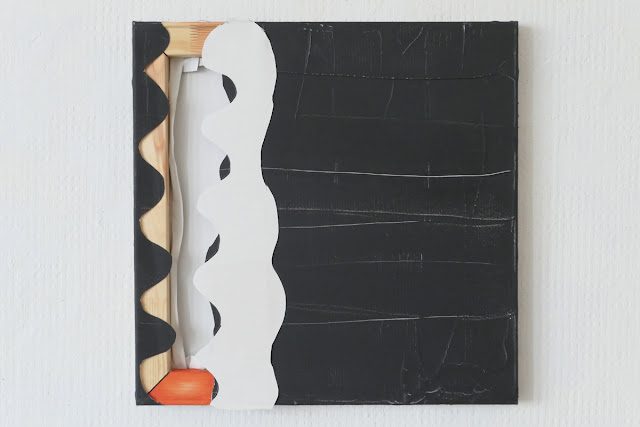 |
GOODYGOODEYE, 2020, 50x50x4cm (19.7x19.7x1.6), plastic board, cutout, collage, gesso, acrylic and pigment on canvas and wood. / And now, a few free wheeling words: Nous ne pouvons voir que ce qui nous regarde (we are able to see only what watches us = & ≠ we are able to see only what concerns us); because maybe even fishes have bones; but as Immanuel Kant wrote in his 'Critique of practical reason': Act in such a way that the maxim of your will can always be valid as a principle of legislation for everyone. Yeaaah! This is an exciting ultimate extension of the Ten Commandments, and also quite comical, since, if this were possible, we would probably arrive fairly quickly to cataclysmic universal generalizations in their concrete results. But it is also very interesting in this that this assertion radically separates ethics from morality, which is only a blind and deaf obedience to the customs in force at such or such epoch, concerning such or such group. Well, you never waste your time reading a bit of philosophy, it's always refreshing and can be at times frankly hilarious; actually it recalls me Hegel asserting that if Africans are black, it is because they live in the night of the Mind. Yeaaah!
|


---
 |
| TELESCOPE (doesn't sound the end of the world), 2020, 170x150x145cm (67x59x57"), Gesso and black Gesso on glued cardboard boxes. |
---
 |
ATLAS, 2020, Ø 234cm (93"), lacquer paint and charcoal on cardboard. / In very very, very ancient times, Zeus had condemned Atlas to carry the world on his shoulders, and Atlas, who was a smart guy despite his pathetic grimaces, had at once noticed that Earth is flat and that between a surface and a line it's a matter of rotation, and he whispered in his beard: "Hey, man, cool, that's super light! But, fuck, what a world anyway, poor fellows are so hungry that they have already eaten up all the toilet paper!"
|
---
 |
| CLOUD OF FLEAS, 2020, each 24x18cm (9.5x7.1"), cutout, collage, paper, plaster, canvas, stretchers, charcoal, acrylic, ink, lacquer paint, Gesso, oil, shoe polish, sealant. / Hey! two months ago, after years! TEDi, our fav one-euro-shop, has got again these sharp edged little cheap canvases i like so much. Bought forty of them. |
---



 |
| TEN PAST TEN (doesn't spell the end of the world), 2020; 50x50x7cm (20x20x2.8"), cutout, Gesso, acrylic and oil on two canvases glued together. / By the way, and without minimizing at all the seriousness of the situation but only in order to restore a balance with the moral heaviness of some groans i read currently from colleagues who are so shocked that they can't work anymore (or even who work too much!), i'm tempted to presume that the corona virus (about which China has curiously so much and more communicated, likely in order to attest how deep concerned the State is about the good health of its citizens comrades, and about its respect for humans rights) has maybe infected well more heads than lungs. Without trying to identify one to the other two neighboring phenomena, but with the aim of noting the astonishing disproportion of media discourse ranging in these cases from relative indifference and planetary catastrophism, to quote figures from the Institut Pasteur, one of the most serious and respectable international medical research centers, influenza (cousin of the corona, same target, same propagation, same symptoms and subject also to seasonal mutations, the both ones under watch for a long time, among other tiny Nature's critters) is responsible for between 10,000 and 15,000 deaths per year in France. (And don't forget that the average duration of a flu epidemic is only nine weeks.) But no one has made a drama of it to date i'm afraid. Well, it's fun, i must have a weird mind, but through their similar formulations and their suspect accumulation, the sighs of this pathetic choir lead me to believe that some were just waiting to finally obey and conform. So maybe it's time to revisit this movie by Don Siegel: Invasion of the body snatchers, 1956. |
---
 |
TWO (couple), early 2020; 40x30cm (15.7x11.8") and 30x24cm (11.8x9.5"), acrylic, oil and lacquer paint (partially sanded) on canvas.
|
---
 |
| Collage, 170x170x4cm (67x67x1.6"), acrylic, linen, charcoal, cut-out on canvas on stretchers. |
---
 |
AND THE TWO THIEVES, 2020; each 30x24X5cm (11.8x9.5x2"), black Gesso on wood, cutout and collage on canvases.
|
---
 |
BOW and BYE. These two paintings have crystallized simultaneously around the memory of my father who passed away five years ago. / BOW, 2020, 50x50x4cm (19.7x19.7x1.6"), gesso, acrylic and sanded Vincent's paint on canvas; and BYE, 2020, 185x185cm (72.8x72.8"), acrylic, oil stick, oil and lacquer paint on linen. / It's the first time that i paint on a canvas of this quality. A few months ago i made a mistake and ordered a roll of canvas which i had underestimated the price; 470 bucks, it's a lot for me. So it took me a while to dare to start using it... / But i'm afraid that i have not managed, despite all my efforts, to make photos reflecting the richness and complexity of the surface, or to render the texture of it. It is true that it is difficult to photograph the nothing, even if it makes you suffer in one way or another. The memory is similar to the skin, it can be hit by bullets or pierced by an arrow that will leave permanent scars, incomprehensible pain, but it is useless to protest against blows whose causes have disappeared.
|








---
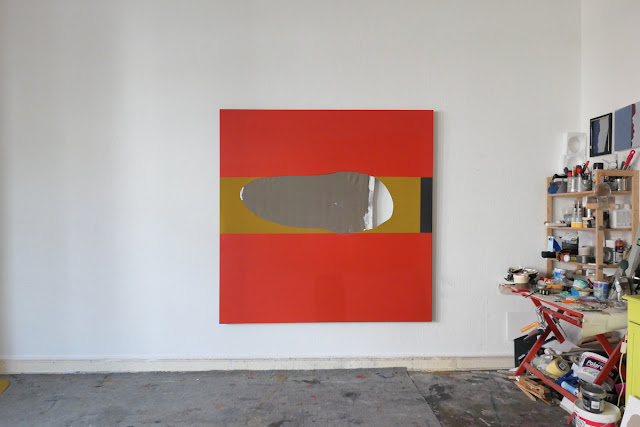 |
| The hole, 170x170x4cm (67x67x1.6"), cut-out, oil and gesso on canvas on stretchers. |
---
 |
| Mirrors, 30x24cm (11.8x9.5") and 30x30cm (11.8x11.8x1.6"), cutout, acrylic, black Gesso, lacquer paint and oil on canvases. |
---
 |
| Lines, 41x29cm (16x11.4"), 24x18cm (9.5x7"), acrylic and oil on canvas. |
---
 |
| TO SEE, 2020, 40x40x5cm (15.8x15.8x2"), cutout, acrylic, oil and lacquer paint on canvas on stretchers. / Question of painting: what is to see, beyond cultural ways and personal methods. How do we see what we see and how do we see that we see? When we see we apply a surface to other surfaces. The invisible surface of the eye sticks to the surface of the air, transparent, itself matching other surfaces, opaque and therefore visible. And it's a game of almost simultaneous back and forth. It is for this "reason" that you can feel yourself looked at by a mountain, for example. Of course, when what we are looking at also has eyes, the situation is even more complex, even sophisticated. But the importance of the eye as an organ should not be overestimated, since a hand resting on a table can perfectly stare at us. So it means that the hand has eyes too, sometimes. |
---
 |
| MISMATCH, 50x50x8cm (20x20x2"), 2020; sealant, cutout, gesso, acrylic, oil and lacquer paint on canvas. / Sorry, too lazy to write a comment today, b'cause it's Sunday and the sky is gray, weather is rainy it drives you crazy, then i need a rest and forget the rest (:-). |
---



 |
It remained me two canvases of the
same format and size exhibited with others in a show that took place at the
Saalbau, the Municipal Gallery of Neukölln, Berlin, in 2009. Both of these paintings
were made up of stripes. I had reworked them recently without having the least
idea of combining them. I was relatively pleased with the work, but actually
they seemed to me a bit 'noisy'. Let's say, very noisy and trying to catch
attention. Finally, relatively to their close structures, i juxtaposed them in
order to see what would happen. It worked pretty well up to a point, but it was
still too effective, so i wondered about what it was possible to do with that,
then doubled and superposed them in different ways until the possibility of a
stable image appears, at least in theory, since at this point i only could
imagine a possible result through these blind tests. An important point was also
that the two frames and stretchers had to coincide in a not too silly way, in
order to prolong the perception of the painting outside the surface itself,
especially on the left side. Once this balance was found, i glued them to each
other with sealant and i practiced the large cut revealing the painting under
and exposing two parts of the wood. Then, looking at the piece of cut canvas, i
told myself that i could reuse a part of it in order to ‘complicate’ the perception.
So i cut a strip, which i stuck upside down on the background painting, at the
edge of the cut, and it worked little by little, by repositioning. Then i reworked
the right edge by painting some of the wood with gray and blue lacquer paint,
always with the same idea: to complicate the perception, to make it 'rich', to
transform the brutality of the process so that the totality of the work is
found to be unified, and no longer detuned by the process and the material
itself. As such, among other things, the gray diagonal plays a big rôle,
because it is it which frees the chassis from its simple utilitarian use, and
which gives to it a dynamic fonction, which is not without activating, by a
kind of visual resistance, the global verticality of the whole thing. After
that i took care of the upper part, on the right, which competed too violently
with the 'decorative' alternation of gray and brown at the bottom on the right.
Finally i painted some parts of the rear chassis in white, which some yellow
drops made obnoxiously aggressive, in the tradition of the worst pop art, and
that's all, folks, that’s how i at once open and closed the window.
'Window', 40x40x5cm (15.7x15.7x2"), sealant, collage, cutout, acrylic and oil on canvas.
|
---
 |
| Reworked some little fishes 2019. / Cutout, collage, ink, acrylic, sealant, oil, canvas, stretchers. |
---
 |
| Deeply flat, 2020, 26x22cm (10.7x10.3"), cutout, ink, acrylic and oil on canvas on stretchers. / The cross of visual planarity, depth and perspective is an essential part of the practice, even without being really questioned, as a subject, as a matter, as a topic. It's a bit like wondering why, when you throw some small pieces of paper in the trash, why they move away from each other, so that often one of them falls next to it. You pay attention to it for a moment, the time to lower yourself while grumbling inwardly, and then you forget, because you believe that you have better to do. |
---
 |
| Butterfly, 80x78x26cm (31.5x30.7x10"), acrylic, gouache and collage on folded cardboard. |
---
 |
| Bulbs |
---
 |
Birdhouse after the storm, 50x30x24cm (19.7x11.8x9.5"), acrylic and gouache on reverted and folded cardboard box.
|
---
 |
| The artichoke, acrylic and gouache on cut and folded cardboard, 32x40x14cm (12.6x15.7x5.5"). |
---
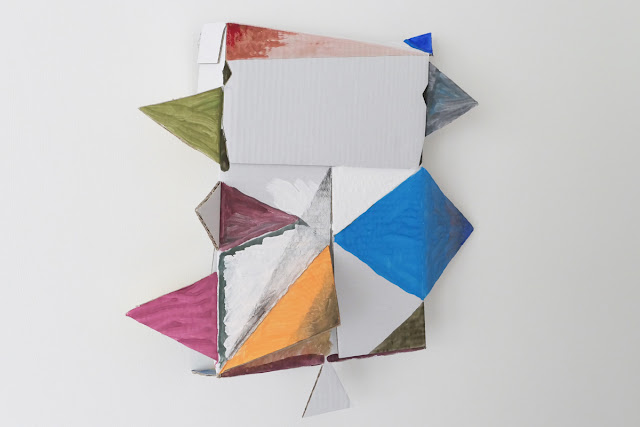 |
| Obvious, acrylic and gouache on cut cardboard, 49x47x22cm (19x18.5x8.7"). |
---
 |
| Study for a volume, acrylic and cardboard, 45x48x29cm (17.7x19x11.4"). |





---
 |
Skew, 20x26cm (7.8x10.2"), plastic sheet, cut-out, collage, acrylic and oil on canvas and stretcher. / The background, the ground, the corners, the folds, the angles, the triangles, the shadows, the oblique, the diagonals, the pattern and the rhythm, the surface and the appearance; in painting the fake is the motive, the reason and the real.
 |





---
 |
Small interior with bouquet. / I have noticed in use that relatively often my paintings come in pairs, the first attracting the second, either to complete or to criticize it, or both at the same time; which doesn't mean that this 'movement' is chronological, since sometimes the first one is an approach to solutions, or questions, which are completed in the second one (but not always). And as these paintings refer to the previous ones, which means sometimes to works dating back ten or twenty five years, not to mention the active memory of live artists or old masters, i suppose that this is a kind of permanent dialectic, here. / Bouquet, 50x40cm (20x11.8"), Wallpaper, 40x30cm (15.7x11.8"), ink, acrylic and oil on canvas.
|
---
 |
| Entangled, 46x37x20cm (18.9x14.6x7.9"), gouache and acrylic on folded cardboard. |
---
 |
| Study, 40x20x20cm (15.7x7.9x7.9") gouache and acrylic on folded cardboard. |
































